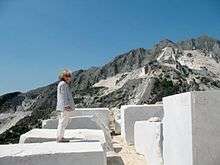Amalia Del Ponte
Amalia Del Ponte (born 1936) is an Italian artist and designer.[1] She has been reviewed positively by some important critics and art historians, such as Guido Ballo, Bruno Munari, Gillo Dorfles, Arturo Schwarz, Francesco Tedeschi, Flaminio Gualdoni and Tommaso Trini. Del Ponte's work has been described as being suspended between art and science, through studies that investigate the relationship between sculpture, music, science and technology.[2] Her international debut in the 1970s won First Prize for Sculpture at the São Paulo Art Biennial.[3]

Early life and education
Del Ponte was born in Milan in 1936.[1] Between 1956 and 1961, she studied sculpture under Marino Marini[4] at the Accademia di Brera in Milan with Kengiro Azuma, Mario Robaudi and Gianni Colombo. In the 1960s, she started her research on materials. Her approach, almost scientific, led Del Ponte to create simple and pure structures.
Career
In 1965 Amalia Del Ponte made her first sculptures in Plexiglas, based on an analysis of basic geometric shapes. Two years later Vittorio Fagone named these works Tropi during a solo show at Galleria Vismara in Milano.[5][6] In the 1960s Del Ponte also designed the interiors of the fashion boutique Gulp! in Milan, and Elio Fiorucci's first shop.[7]
Del Ponte received international acclaim in 1973 when she was invited by Bruno Munari and Umbro Apollonio to participate at São Paulo Art Biennial (at that time one of the most important in the world) where she won First Prize for Sculpture with her work Area percettiva.[8] In 1993, Del Ponte exhibited some of her lithophones at Fort Asperen in the Netherlands.
In 1995, Gillo Dorfles invited Del Ponte to participate at the Venice Biennale, with a room dedicated to her work inside the Italian Pavilion.[9] Here she exposed an original set-up of lithophones, described as "sound stones that point out the invisible correspondences between geometric shapes, musical scales and colors".[10]
In 2010 she created a project for Certosa Island in the Lagoon of Venice; this was a series of video installations set up in the four Case Matte. The art work, entitled Regno dei possibili, invisibili, is about how art and science make otherwise invisible reality visible.[11][12][13][14]
References
- delponte, amalia (2011-03-16), Amalia Del Ponte - Intervista di Mario Gamba per Notte Cultura Rai 3, retrieved 2019-02-16
- "Amalia Del Ponte di Cristina Casero su Titolo". 1995-2015.undo.net. Retrieved 2019-02-16.
- documentario su Amalia Del Ponte (in Italian).
- http://farahzadart.com/080109.html
- (in Italian) http://www.amaliadelponte.org/AmaliaDelPonte/tropi.html
- (in Italian) http://archiviostorico.corriere.it/1994/gennaio/30/esperimenti_con_musica_co_0_9401306877.shtml
- delponte, amalia (2012-04-24), Amalia Del Ponte e Elio Fiorucci - intervista di Matteo Giacometti, retrieved 2019-02-16
- http://issuu.com/bienal/docs/namee1bdf4
- (in Italian) http://www.fondazioneitaliani.it/index.php?option=com_content&task=view&id=698&Itemid=43
- "Archived copy". Archived from the original on 2014-05-03. Retrieved 2014-02-13.CS1 maint: archived copy as title (link)
- (in Italian) http://www.actv.it/regnodeipossibiliinvisibilimostradiamaliadelponteinaugurazione26giugnofinoal26settembre0
- (in Italian) http://www.comune.venezia.it/flex/cm/pages/ServeBLOB.php/L/IT/IDPagina/37531 Archived 2014-02-23 at the Wayback Machine
- http://www.agendavenezia.org/en/evento-18651.htm
- (in Italian) http://www.connessomagazine.it/amalia-del-ponte-regno-dei-possibili-invisibili
Links
Official Web Site http://www.amaliadelponte.org/adp/en/